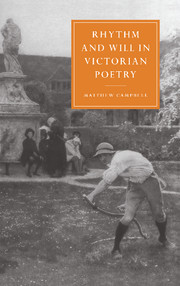Book contents
- Frontmatter
- Contents
- Preface and acknowledgements
- Texts used
- Chapter 1 Introduction: two decisions
- Part One RHYTHMS OF WILL
- Chapter 2 Rhythms of will
- Chapter 3 Tennyson, Browning and the absorbing soul
- Part Two MONOLOGUE AND MONODRAMA
- Part Three MAKING A WILL
- Notes
- Bibliography
- Index
- CAMBRIDGE STUDIES IN NINETEENTH-CENTURY LITERATURE AND CULTURE
Chapter 3 - Tennyson, Browning and the absorbing soul
Published online by Cambridge University Press: 22 September 2009
- Frontmatter
- Contents
- Preface and acknowledgements
- Texts used
- Chapter 1 Introduction: two decisions
- Part One RHYTHMS OF WILL
- Chapter 2 Rhythms of will
- Chapter 3 Tennyson, Browning and the absorbing soul
- Part Two MONOLOGUE AND MONODRAMA
- Part Three MAKING A WILL
- Notes
- Bibliography
- Index
- CAMBRIDGE STUDIES IN NINETEENTH-CENTURY LITERATURE AND CULTURE
Summary
The purpose of rhythm, according to W. B. Yeats in ‘The Symbolism of Poetry’ (1900), is ‘to prolong the moment of contemplation … by hushing us with an alluring monotony, while it holds us waking by variety, to keep us in that state of perhaps real trance, in which the mind liberated from the pressure of the will is unfolded in symbols’. For Yeats, this passive acquiescence in rhythm was betrayed by a poet such as Tennyson, for whom the descriptive, the moral, the anecdotal and the scientific ‘so often extinguished [his] central flame’. Advocating a return to a symbolist poetry, Yeats has this to say of its prosodic form:
With this change of substance, this return to imagination, this understanding that the laws of art, which are the hidden laws of the world, can alone bind the imagination, would come a change of style, and we would cast out of serious poetry those energetic rhythms, as of a man running, which are the invention of the will with its eyes always on something to be done or undone; and we would seek out those wavering, meditative, organic rhythms, which are the embodiment of the imagination, that neither desires nor hates, because it has done with time, and only wishes to gaze upon some reality, some beauty ….
Yeats' desire is to lose the Victorian rhythms of will which interfere with the timeless, if passive, gaze of the embodied imagination.
- Type
- Chapter
- Information
- Rhythm and Will in Victorian Poetry , pp. 64 - 96Publisher: Cambridge University PressPrint publication year: 1999



